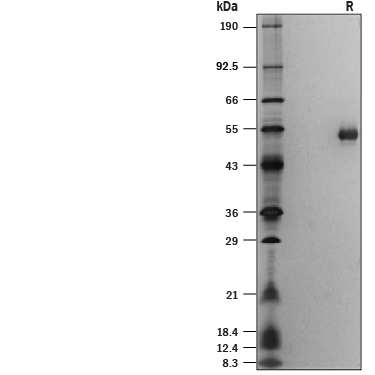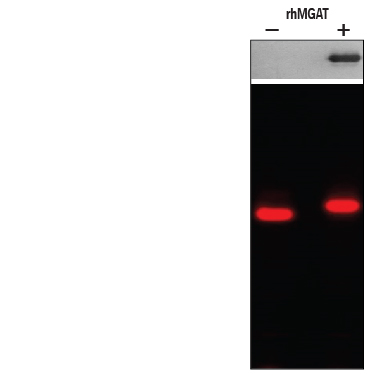Recombinant Human N-Acetylglucosaminyltransferase2/MGAT2, CF
Recombinant Human N-Acetylglucosaminyltransferase2/MGAT2, CF Summary
Product Specifications
Able to convert >50% of the substrate glycan M1N1f to the product glycan, as measured under the described conditions.
Asn34-Gln447, with N-terminal HA tag
Analysis
Tyr of HA tag
Product Datasheets
Carrier Free
CF stands for Carrier Free (CF). We typically add Bovine Serum Albumin (BSA) as a carrier protein to our recombinant proteins. Adding a carrier protein enhances protein stability, increases shelf-life, and allows the recombinant protein to be stored at a more dilute concentration. The carrier free version does not contain BSA.
In general, we advise purchasing the recombinant protein with BSA for use in cell or tissue culture, or as an ELISA standard. In contrast, the carrier free protein is recommended for applications, in which the presence of BSA could interfere.
10711-GT
| Formulation | Supplied as a 0.2 μm filtered solution in Tris and NaCl. |
| Shipping | The product is shipped with polar packs. Upon receipt, store it immediately at the temperature recommended below. |
| Stability & Storage: | Use a manual defrost freezer and avoid repeated freeze-thaw cycles.
|
Assay Procedure
- Assay Buffer: 25 mM Tris, 10 mM CaCl2, 10 mM MnCl2, pH 7.5
- Recombinant Human MGAT2 (rhMGAT2) (Catalog # 10711-GT)
- Uridine 5-diphospho-N-acetylglucosamine (UDP-GlcNAc) (Sigma, Catalog # U4375), 50 mM stock in 50% Ethanol
- Uridine 5-diphosphogalactose disodium salt (UDP-Gal) (Sigma, Catalog # U4500), 10 mM stock in deionized water
- Cy5-labeled M1N1f (Catalog # GL301)
- Recombinant Human B4GALT1 (rhB4GALT1) (Catalog # 3609-GT)
- 15% SDS-PAGE gel and SDS-PAGE reagents
- Fluorescent imager
- Dilute rhMGAT2 to 10 µg/mL in Assay Buffer.
- Create Reaction Mixture A containing 0.130 µM Cy5-labeled M1N1f and 1.5 mM UDP-GlcNAc in Assay Buffer.
- Combine 10 µL of 10 µg/mL rhMGAT2 and 10 µL of Reaction Mixture A. Prepare a control by combining 10 µL of Assay Buffer and 10 µL of Reaction Mixture A.
- Incubate the reaction and control at 37 °C for 30 minutes.
- After incubation, heat at 90 °C for 2 minutes. Cool on ice and quickly spin down condensation.
- Create Reaction Mixture B containing 50 µg/mL rhB4GALT1 and 1.5 mM UDP-Gal in Assay Buffer.
- Add 10 µL of Reaction Mixture B to the reaction and control.
- Incubate the reaction and control at 37 °C for 20 minutes.
- Add 6 µL of the reducing sample buffer to reaction and control.
- Load 15 µL per lane of each reaction and control on a 15% SDS-PAGE gel and perform SDS-PAGE. Let samples run down approximately 80% of the length of the gel.
- Visualize the gel with a fluorescent imager and calculate percent conversion.
Per Reaction:
- rhMGAT2: 0.1 µg
- Cy5-labeled M1N1f: 1.3 pmol
- UDP-GlcNAc: 0.5 mM
- rhB4GALT1: 0.5 µg
- UDP-Gal: 0.5 mM
Scientific Data
 View Larger
View Larger
MGAT2 (Catalog # 10711-GT) recognizes an unmodified GlcNAc residue installed by MGAT1 (8334-GT) in the alpha 3 arm of the trimannose core of N-glycans and transfers a second GlcNAc residue to the alpha 6 arm of the structure to generate product glycan M2. MGAT2 can tolerate core-6 fucose and its Cy5 derivatives.
 View Larger
View Larger
1 μg/lane of Recombinant Human MGAT2 His-tag (Catalog # 10711-GT) was resolved with SDS-PAGE under reducing (R) conditions and visualized by silver staining, showing bands at 46-54 kDa.
 View Larger
View Larger
Lane 1 contained substrate glycan M1N1f' (GL302). In the presence of rhMGAT2, the glycan was modified and a mobility shift was observed.
Reconstitution Calculator
Background: N-Acetylglucosaminyltransferase 2/MGAT2
Mannosylglycoprotein N-acetyl-glucosaminyltransferase 2 (MGAT2) is a key enzyme for the synthesis of complex type N-glycan. It specifically recognizes an unmodified GlcNAc residue installed by MGAT1 in the alpha 3 arm of the trimannosy core of N-glycans and transfers a second GlcNAc residue to the alpha 6 arm of the structure, thereby initiating the conversion of oligomannose type N-glycan to the complex type N-glycan (1-3). MGAT2 is a Golgi resident type II membrane protein with a typical domain structure of glycosyltransferases, containing a short N-terminal cytoplasmic domain, a hydrophobic non-cleavable signal-anchor domain, and a C-terminal catalytic domain (4). MGAT2 Mutations lead to type II carbohydrate-deficient glycoprotein syndrome (5) and abnormal brain development (6). Additionally, MGAT2 maybe involved in glycoantigen presentation and T cell activation (7). The activity of recombinant MGAT2 is demonstrated in an electrophoretic gel mobility shift assay using a fluorophore-labeled core N-glycan as the substrate.
- Moremen, K.W. and Haltiwanger, R.S. (2019) Nat. Chem. Biol. 15:853.
- Kadirvelraj, R. et al. (2018) Proc. Natl. Acad. Sci. USA 115:4637.
- Schachter, H. (1986). Biochem. Cell Biol. 64:163.
- Paulson, J.C. and Colley, K.J. (1989). J. Biol. Chem. 264:17615.
- Wang, Y. et al. (2001) Glycobiology 11:1051.
- Tan, J. et al. (1996) Am. J. Hum. Genet. 59:810.
- Ryan, S.O. et al. 2014 Glycobiology 24:262.
FAQs
No product specific FAQs exist for this product, however you may
View all Proteins and Enzyme FAQsReviews for Recombinant Human N-Acetylglucosaminyltransferase2/MGAT2, CF
There are currently no reviews for this product. Be the first to review Recombinant Human N-Acetylglucosaminyltransferase2/MGAT2, CF and earn rewards!
Have you used Recombinant Human N-Acetylglucosaminyltransferase2/MGAT2, CF?
Submit a review and receive an Amazon gift card.
$25/€18/£15/$25CAN/¥75 Yuan/¥1250 Yen for a review with an image
$10/€7/£6/$10 CAD/¥70 Yuan/¥1110 Yen for a review without an image
